Finding Nirvana in Numbers
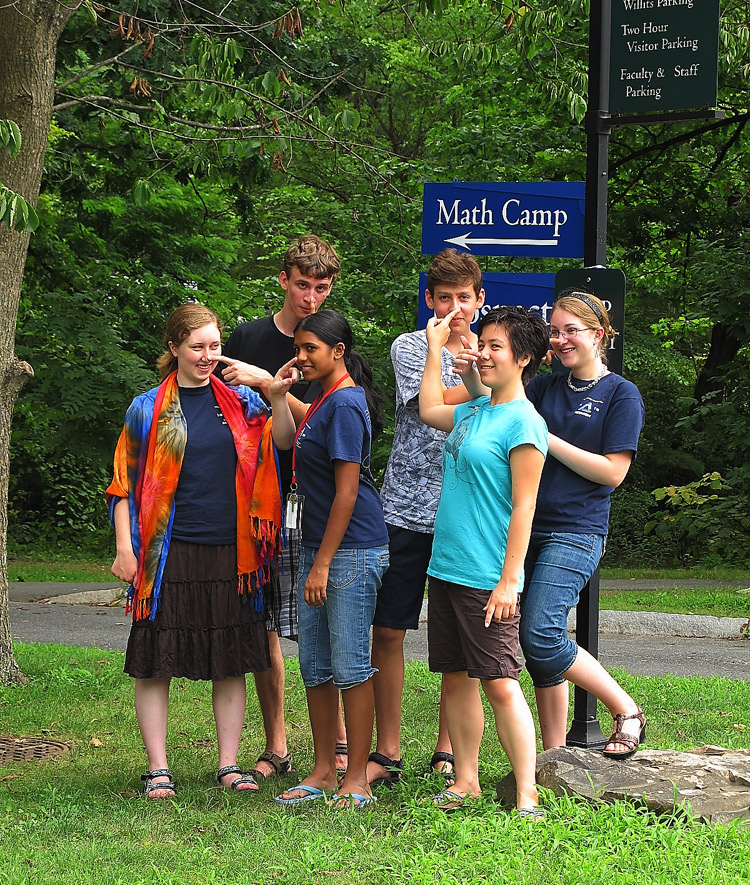 Mount Holyoke College, South Hadley, MA—
Mount Holyoke College, South Hadley, MA—
Blindfolded and calculating aloud in Latin, Adam Hesterberg is in Heaven.
This is to say that: 1) he is at Mathcamp; and 2) his problem-solving relay team, aptly named Go To Hell, has solved a sufficient number of problems to advance from the starting gates of Hades, on one side of the gymnasium, to numerical Nirvana, on the other.
“We had a fast influx into Heaven,” explains his Go To Hell teammate Yuval Wigderson, 15, a tenth grader at Princeton High School. He was also in Heaven. And with each correctly solved problem, another teammate joined the Heavenly ranks. Though Go To Hell’s quick success, it must be said, was due in large part to Hesterberg….
A fourth-year mathematics undergrad at Princeton University, Hesterberg, 21, was back at Mathcamp for reunion weekend, having attended as a camper four years running in his teens. “Almost all the mathematician I am is because of Mathcamp,” says Hesterberg, who plans to pursue a Ph.D. in combinatorics at maybe MIT, UC Berkeley, Georgia Tech, or Waterloo in Ontario.
 He signed up for the reunion within five minutes of receiving the e-mail invitation. And his past camp achievements explain why he was blindfolded and speaking Latin during a relay. In problem-solving relays, teams combined alums with current campers, aged 13 to 18; and the alumni, depending on their problem-solving records, were slapped with various handicaps. If an alum had won one problem-solving relay in their Mathcamp history, they weren’t allowed to write anything down; six wins and they were blindfolded; ten and they had to speak only Russian or Latin. Hesterberg had arguably won more than ten relays in his Mathcamp history. Luckily, he speaks fluent Latin due to a serious linguistics hobby, and his teammates made use of an Oxford Latin Mini Dictionary provided in their relay kit.
He signed up for the reunion within five minutes of receiving the e-mail invitation. And his past camp achievements explain why he was blindfolded and speaking Latin during a relay. In problem-solving relays, teams combined alums with current campers, aged 13 to 18; and the alumni, depending on their problem-solving records, were slapped with various handicaps. If an alum had won one problem-solving relay in their Mathcamp history, they weren’t allowed to write anything down; six wins and they were blindfolded; ten and they had to speak only Russian or Latin. Hesterberg had arguably won more than ten relays in his Mathcamp history. Luckily, he speaks fluent Latin due to a serious linguistics hobby, and his teammates made use of an Oxford Latin Mini Dictionary provided in their relay kit.
But the presence of alumni at Mathcamp had more than tactical or nostalgic utility during reunion weekend (about 50 alumni attended) and during the five weeks of summer that comprise a camp session. Former campers also make up the majority of counselors, mentors, and teaching visitors and make the five weeks of Mathcamp the place it is—a haven where mathematically inclined kids get their feet wet, not just in pools and lakes, but also in the big wide ocean that is the real world of research mathematics. (Canada/USA Mathcamp, as it is formally called, was founded in 1993 by mathematician George Rubin Thomas, who in 2002 went on to start a similar camp, MathPath, for kids aged 11 to 14.)
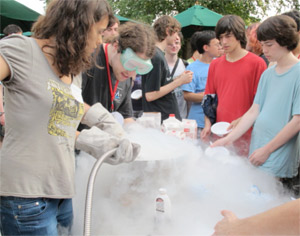
“Mathcamp was my first exposure to what being a mathematician was going to be like; it was my first exposure to people who actually did research math,” says David Roe, waiting in the dinner line for some spaghetti. Roe, now 26, is a fifth-year Ph.D. candidate studying algebraic number theory at Harvard. He was a Mathcamper for four years, starting in the early days in 1999, and has returned the eight years since as a counselor, mentor, and visitor. “I have spent one year total at Mathcamp,” he notes.
“I think the interesting part,” Roe says, “is the distinction between the math you see in high school, the math you’ll see in competitions, and the math you’ll learn in classes at camp. At Mathcamp you get exposed to a much bigger diversity of topics.”
This sentiment is seconded ad inifinitum by everyone asked.
“I was like, wow, I had no idea all this stuff existed,” says 16-year-old Meena Boppana (e-mail prefix “meenamathgirl”), going into the 11th grade at Hunter College High School in New York City.
“High school math is this rigid thing that your teacher teaches,” confirms Meng Zhao, 16 and heading into the 12th grade at Western Canada High School in Calgary. “This shows you what math really is. It’s like this whole universe. It’s not just a bunch of problems on paper that you have to finish.”
 “Problem solving is all good, but it becomes a little pointless after a time,” says Aniruddha (Ani) Bapat, 18, from India and heading into his freshman year at Caltech. “I felt a bit directionless. That’s when I applied to Mathcamp. Its focus is beyond problem solving, giving you a flavor of math as it is, truly…You develop a mathematical mind, a mathematical maturity.”
“Problem solving is all good, but it becomes a little pointless after a time,” says Aniruddha (Ani) Bapat, 18, from India and heading into his freshman year at Caltech. “I felt a bit directionless. That’s when I applied to Mathcamp. Its focus is beyond problem solving, giving you a flavor of math as it is, truly…You develop a mathematical mind, a mathematical maturity.”
“The main thing I got out of Mathcamp was an exposure to a broader variety of math,” says Eric Wofsey, 20, a third-year grad student in math at Harvard. His favorite T-shirt is light pink and declares I’M TOO PRETTY TO DO MATH. Wofsey, now a camp mentor and known to everyone as Waffle, went to college at age 15. His parents were not certain Mathcamp would have anything to offer him, but it turned out Mathcamp classes provided greater breadth than his undergraduate mathematics curriculum.
That said, all classes at camp are optional. Campers have total freedom to decide how they spend their time. Not surprisingly, they choose of their own volition to spend a good amount of time in the classes, which this summer included sessions on p-adic numbers, Bernoulli numbers, vector fields, complex analysis, representations of finite groups, multilinear algebra, algebraic curves, matrix game theory, theoretical computer science, combinatorial inequalities, paradoxes of probability, field extensions and automorphisms, and probabilistic methods in graph theory—and that’s just a random sampling from week three.
The previous week, Roe had taught an advanced evening class featuring two papers by Princeton mathematician Manjul Bhargava. The first was on composition laws, generalizing those for quadratic forms, and the second on an unconditional bound for the average rank of an elliptic curve. Then, in keeping with the spirit of camp, he came back a week later for reunion weekend and performed the crucial role of dessert chef, hand stirring the liquid-nitrogen ice cream, a Mathcamp Saturday tradition, that drew a mob of campers out of the dark, dank, smelly common room and onto the cafeteria patio.
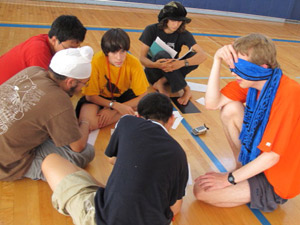
Kids craving more math than their schools can provide and forging their own way is the norm outside Mathcamp. But here they have a chance to get more than their fill by hobnobbing with “real mathematicians”: this summer those in attendance included SUNY computer scientist and mathematical sculptor George Hart; Larry Guth, a geometer and functional analyst at the University of Toronto; geometric topologist and group theorist Moon Duchin, a postdoc at the University of Michigan; and Avi Wigderson, Yuval’s father and a mathematician and theoretical computer scientist at the Institute for Advanced Study in Princeton, who tries to understand questions like “Is multiplication harder than addition?”
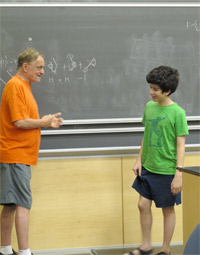
After attending a lecture by Princeton mathematician John Horton Conway on his 1970s discovery of surreal numbers, one audience member, Itai Bar-Natan, 14 and going into the ninth grade at The Abelard School in Toronto, seems nonchalantly unimpressed (his parents are University of Toronto mathematicians Dror Bar-Natan and Yael Karshon). He confesses with a shrug that he has already read Conway’s book on the subject, On Numbers and Games, a title directed at professional mathematicians though rendered in Conway’s trademark playful and unpretentious style. Bar-Natan’s summer reading at camp includes A Certain Ambiguity, a scholarly novel published by Princeton University Press. He skipped the white-water rafting excursion to read and play games in the camp common room.
Another young first-year camper who forwent the white-water rafting was James Tao, a ninth grader from Illinois, who celebrated his 14th birthday at camp. Tao seized every opportunity to pick Conway’s brain. He was quite taken with the weeklong “Conway Hour,” in part because Conway refused to choose or announce his lecture
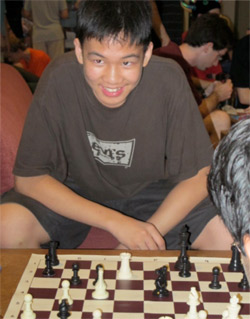
subjects ahead of time. Instead, each lecture began with Conway presenting a selection of topics and soliciting the audience’s vote on what they’d like to hear. Tao was awed not only by the breadth of the professor’s impromptu ken but also by the way his lectures seemed to re-create the discovery process rather than simply report the result.
“I feel that is something that’s lacking in my conception of what mathematics is,” says Tao, who admits that he originally did math because everyone convinced him that doing math made you smart; then he realized that there was more to it. “Maybe I know the theorems,” he says, “and maybe I know how to prove some of the theorems, and maybe I know how to discover some easy theorems. But I think what I don’t know is what people do when they say they do research. And I think talking with someone who has done research and hearing someone lecture about their research is very helpful for learning that.”
Practically speaking, over the course of the summer, campers have the option of doing a long-term project, a mini baptism of sorts into research  mathematics; Tao is studying the Euclidean dimension of graphs. As in research, a good part of the fun of the projects is figuring out what question to ask and not knowing whether the question asked does indeed have an answer. On a few occasions, these projects have resulted in papers in scholarly journals, such as 2004 alum Ted Singer’s “Harmonic Algebraic Curves and Noncrossing Partitions,” published in Discrete & Computational Geometry (co-authored by camp visitor Jeremy Martin and faculty member and deputy director David Savitt).
mathematics; Tao is studying the Euclidean dimension of graphs. As in research, a good part of the fun of the projects is figuring out what question to ask and not knowing whether the question asked does indeed have an answer. On a few occasions, these projects have resulted in papers in scholarly journals, such as 2004 alum Ted Singer’s “Harmonic Algebraic Curves and Noncrossing Partitions,” published in Discrete & Computational Geometry (co-authored by camp visitor Jeremy Martin and faculty member and deputy director David Savitt).
But it’s clear that simply the contact with Conway and other bona fide mathematicians in situ—the chance to see how their brains work and to probe them with incessant questions—is what really cracked open Tao’s brain in return.
“It’s interesting to see how Conway does research, how he thinks about these problems, how he thinks problems are related. There is a certain feeling and a certain intuition that you get about certain areas in math,” Tao says. “And it’s really interesting when you can tie these areas together and tie the intuition together so you can actually understand what’s going on—when you are analyzing two fields at the same time, say games and numbers. Those are two very different ideas coming together into one, so it’s interesting also to see how people can use their intuition to do that.”
“Once we have this ability, what do we do with it?” Tao asks this question of himself, happily lost in a meta moment at Mathcamp.
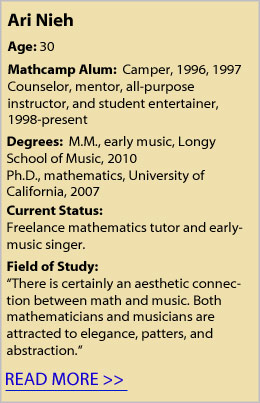 Waiting patiently for their liquid-nitrogen ice cream, a group of campers gamely huddle to consider how Mathcamp increases the slope of their learning curve, no mean feat for kids who are acing math class with marks in the 90s—although the Mathcamp application consists solely of problem solving and an essay (applicants this year numbered 310 for 75 positions, more than doubling the 150 applicants in 2003; total campers number 110, with the balance each year made up by returning campers).
Waiting patiently for their liquid-nitrogen ice cream, a group of campers gamely huddle to consider how Mathcamp increases the slope of their learning curve, no mean feat for kids who are acing math class with marks in the 90s—although the Mathcamp application consists solely of problem solving and an essay (applicants this year numbered 310 for 75 positions, more than doubling the 150 applicants in 2003; total campers number 110, with the balance each year made up by returning campers).
“You study algebra at high school and you think, ‘I know that!'” says Sachi Hashimoto, 17, starting at St. Lawrence University in New York in the fall. “And then you come here and you’re, like, ‘Wait. Nooooo! I don’t.’ And there are all these people who are really good at math—and you’ve never met anyone before who is all that much better than you at math.”
“It also gives you a chance to do math that is really, really hard and get completely lost. No matter how good you are,” says Miriam Gershenson, 18, soon to be a freshman at MIT. “That is definitely fun. And important,” adds Bianca Homberg, 17, going into 12th grade at Westborough High School in Massachusetts.
But then someone yells, “Bianca! There’s ice cream! Vanilla!” and with that the huddle breaks up.
Ice cream is followed by a rousing performance by the camp a cappella group of the camp ballad, “Nonabelian,” sung to the tune of Simon and Garfunkel’s “Cecilia”—
Nonabelian
Nonabelian! You’re breakin’ my heart
You’re wreckin’ my multiplication
Nonabelian! I’m down on my knees
I’m beggin’ you please to commute
Please commute
Thinkin’ groups in the afternoon,
Nonabelian, up in my classroom (thinkin’ groups!)
There are things that just can’t be done
When a b a inverse b inverse is not one
Following “Nonabelian” comes a special session on “The Future of You,” a Q&A panel in the auditorium, in which campers tap the wisdom of the alums with respect to where a career in math might take them.
 Walking from the dorm to the auditorium, Jonathan Love, in the 12th grade at the Christian Academy in Japan, muses about his trajectory to Mathcamp. He wears a digital watch on his right ankle, a blue sarong tied around his shoulders like a cape and a purple one tied at his waist (known around camp as J-Lo, Love adds a third sarong on special occasions, like reunion weekend—sarongs being the official camp “it” accessory).
Walking from the dorm to the auditorium, Jonathan Love, in the 12th grade at the Christian Academy in Japan, muses about his trajectory to Mathcamp. He wears a digital watch on his right ankle, a blue sarong tied around his shoulders like a cape and a purple one tied at his waist (known around camp as J-Lo, Love adds a third sarong on special occasions, like reunion weekend—sarongs being the official camp “it” accessory).
“Before I came to Mathcamp, last year,” he says, “I would be trying to push myself; I like math to the extent that I would be trying to find new things to do. But all I knew was high school math. That was my limited understanding of math. So basically, learning calculus was my success story. ‘I’ve done calculus, I’ve gone as far as I can’—’cause that’s what 12th graders did, and I was in 10th grade at the time. That was my big achievement: ‘I’m done.’ I knew there was further math, that there were these really hard problems that I had no idea how to solve. But my impression was that in terms of actual math topics, it basically went up to calculus and stopped.”
But on the recommendation of a friend, he signed up for Mathcamp, and eureka!
“I was pleasantly surprised. I guess ‘shocked’ would be a better word. Nothing looked remotely like any math I had done in high school. It was all completely new stuff.” Asked for a metaphor, Love, an accomplished musician, obliges by saying that “it was like, in school I was learning how to play scales, and at Mathcamp I learned how to make music.”
Siobhan Roberts is the author of King of Infinite Space: Donald Coxeter, The Man Who Saved Geometry (Walker/Bloomsbury). She is a visitor at the Institute for Advanced Study in Princeton, where she is working on a biography of mathemagician John Horton Conway.
Profiles
•••
 Scott Aaronson
Scott Aaronson
Field of Study:
“I’m mostly interested in quantum computing theory, so I study the capabilities and limitations of computers that would be based on the laws of quantum physics. I sometimes describe it as ‘The study of what we can’t do with computers that we don’t [yet] have.’
“It might sound like a strange thing to study, because we have built very small quantum computers to date—for example, they are able to factor 15 into three times five. But we don’t yet know how to scale it up. We believe it’s possible, consistent with the laws of physics, and so forth, and there are even practical proposals for doing it, but no one has built a scalable quantum computer yet. In the meantime, we can study what the effect of such computers would be on the theory of computation.
“In my opinion, possibly the greatest or one of the greatest open questions in mathematics today is the P versus NP problem. It’s one of the Millennium questions. It basically asks, ‘If you can recognize the solution to a problem efficiently, then can you also find the solution efficiently?’ It is just one example of a broad class of questions—almost none of which we know how to answer—about the ultimate limitations of efficient computation.
“In the 1930s, Alan Turing and Kurt Gödel proved the fundamental theorems that set out what is and isn’t possible using computers in any amount of time. So that is very well understood today. But it’s not what we really want to know. We really want to know what we can do with a computer and get an answer back in a reasonable amount of time.
“If you have some combinatorial search problem—like, let’s say you want to schedule airlines in order to maximize your profit, or you want your computer to find a proof of a mathematical theorem, or you want to do something that would basically be artificial intelligence—you can always solve such problems by just enumerating all the possible solutions one after another. But then the question is ‘Is there a more clever way to do it?’ And that is basically what the P versus NP problem is asking. We believe that the answer is no, there is not such a way, but we can’t prove it.
“What’s interesting is that you can bring in quantum mechanics and it adds a whole new wrinkle to these questions. Because even if classical computers were not able to solve these problems efficiently, a computer built on quantum mechanical principles might be able to… But even quantum computers have limitations. So what I’m interested in is understanding the boundaries: what do quantum computers let you do, what do they not let you do, how do they change the classical picture, [how do they expand] the universe of efficiently solvable problems?”
What I Learned at Mathcamp:
“Mathcamp made me feel like I had a connection to mathematics. I was 15 when I went there, and it was the first time in my life that I had ever been in touch with real mathematicians. I was going to college the year after that. Because I hated my high school; there were very few opportunities for going ahead, and the overall environment was a fairly repressive one. So I wanted to get out of it as quickly as I could.
“I knew that I liked math, and I knew that I liked computers. And I knew something about those subjects because I was constantly reading books on my own. But it always sort of distanced me when I read about the history of mathematics. So, for example, I read a biography of the self-taught Indian mathematician Ramanujan and his famous collaboration with G.H. Hardy at Cambridge. And I might as well have been reading about Plato and Aristotle: it was this long-ago world. And then I went to Mathcamp, and I was talking to someone about this book that I’d read. They said, ‘Oh, well, you should talk to Richard Guy over there; he knew Hardy.’ And then Richard Guy told me stories about Hardy from the 1940s. It was just an amazing experience, to feel like I had some kind of connection to this world.
“In terms of specifically my research interests, Mathcamp was the first exposure that I ever had to computational complexity. Richard Karp, who is a professor at Berkeley, is one of the founders of this field: he wrote a seminal paper in 1972 which was one of two papers which put the P versus NP problem on the map, sort of identified the problem, described it in a modern way, demonstrated what its importance was. He actually gave a lecture series at Mathcamp, and that was my first introduction to complexity theory. It would have been pretty hard to get a better introduction than that!”
 Michal Kapustka
Michal Kapustka
Field of Study:
“My field of study is algebraic geometry. I always liked high school problems in geometry, and algebraic geometry is a branch of mathematics that is closest to them. What I find especially interesting about it is that it requires broad thinking involving many different mathematical structures. From this point of view, it is very difficult but much less technical than other branches of mathematics. It is also very intuitive.
“At the moment, for example, I am working on the geometry of Calabi-Yau threefolds—varieties, or manifolds, which, according to string theory, are the building blocks of the universe. Very little is known in general about these varieties. What I try to do is construct new examples and study their geometry. I find it fascinating that they appear naturally in almost all branches of mathematics. And surprisingly, these abstract objects are sometimes related to very elementary (high school level) geometric problems. Hence they can be studied using the sense of intuition that we developed during our early mathematical studies.”
What I Learned at Mathcamp:
“Mathcamp was my first meeting with high- level mathematics—in particular, my first contact with algebraic geometry. It was at Mathcamp that I first learned how elementary geometric problems can be solved using purely algebraic methods. I enjoyed also the traditional problem-solving sessions and team competition, which helped me develop problem-solving skills. This was also the first, so far the only, time I went to the United States, which made Mathcamp not only a mathematical adventure but also a wonderful cultural adventure.”
 Yvonne Lai
Yvonne Lai
Field of Study:
“At Mathcamp 1996, when I was 17, I was drawn into mathematics by the ‘ambience of beauty,’ to borrow a phrase from the mathematician Hyman Bass, forged in a lecture by John Stillwell. I remember thinking, as an overhead transparency graphic of a 2-genus surface appeared during an explanation of branched covers, ‘If this is what mathematics is, then I want to be a part of it.’
“This reflection ignited a journey into hyperbolic geometry and, later, geometric group theory, the subject of my doctoral dissertation. In Stillwell’s lecture, the mathematics sparkled. As I came across great teachers throughout my undergraduate and graduate years, I realized that I had an intellectual curiosity for both the material that great teachers brought to life as well as for how they animated the mathematics and responded to their students’ queries and concerns.
“Studying the work of teaching, and the mathematical knowledge, skills, and inclinations that it entails, is the subject of my current research. As part of the Mathematical Knowledge for Teaching group at the University of Michigan, I am interested in the specialized ways in which teachers, from K–12 to beyond, must know mathematics to teach skillfully.”
What I Learned at Mathcamp:
“Mathcamp has been a gift of many resources. As a student, I learned mathematical problem-solving strategies and intellectual self-confidence from the classes of Loren Larson, among others. First as a student and later as a teacher, I learned the importance of identifying one’s interests and pursuing them; realized how vitalizing it is to have peers whose social and intellectual inclinations both support and contrast with one’s own; and experienced the reward of watching students, peers, and a program evolve over time.”
 Ari Nieh
Ari Nieh
Field of Study:
“My current field is early music, which includes medieval, Renaissance, and Baroque music. We start around Gregorian chant and go up until Bach and Handel. The central focus of the early-music world is historically informed performance: we look at treatises, manuscripts, and old instruments and create performances that take into account how the music would have been performed back then. I got into it back when I was a grad student at Berkeley. I’d grown up playing violin but only started singing seriously in my early twenties. While I was ostensibly working on my doctorate, I spent rather a lot of time in semiprofessional choirs in the Bay Area.
“There is certainly an aesthetic connection between math and music. Both mathematicians and musicians are attracted to elegance, patterns, and abstraction. Although I no longer do research as a mathematician, I currently teach math for two organizations: Veritas Tutors, a tutoring agency based in Cambridge, and Art of Problem Solving, a mathematics Web site for advanced students.
“With Veritas, I’m usually working with students who need a bit of extra help. Some are advanced students, as well; many are taking calculus BC or linear algebra in high school and just need some additional explanation to get concepts straight. I enjoy working one-on-one because it lets me pace the material optimally for the student. It’s a very efficient way to learn, and it really builds their confidence.
“I also teach for artofproblemsolving.com, a Web site for mathematically talented kids. These are usually bright students who aren’t getting what they want out of normal K–12 math classes, and a few are home schooled. The format is a LaTeX-enabled Java chat room, which works quite well because of the instructor’s ability to filter student comments and have TAs address questions privately.
“In general, I teach because people want to be taught; humans have a strong innate desire to learn and understand things, and having another person to help you along the way is vital. When it comes to math, there’s so much dreary teaching out there: memorization of tools without any conceptual understanding; repetitive calculations; and nonsensical, scattershot curricula. It’s a mess, and if I can help a student make sense of it, I’m doing my part.”
What I Learned at Mathcamp:
“As a student I learned some useful mathematics: geometry from Euclid’s Elements, modular arithmetic, basic number theory, problem-solving techniques, and other minor things. Back then it wasn’t as strong a program, academically or socially, as it is today. But I still had an excellent time, because I was around other people who enjoyed what I enjoyed, and I got along with them well.
“As a staff member, I learned innumerable skills: organization, leadership, discipline, pedagogy, teamwork, communication, conflict management, prioritization…running this kind of program is extremely difficult to do well, and we’ve spent a lot of time improving over the years and growing as individuals and as a team. Organizing other projects is a piece of cake for me because I’ve helped run Mathcamp.”
 Charles Steinhardt
Charles Steinhardt
Field of Study:
“Currently I’m in high-energy astrophysics. If I could have been around for any historical moment of discovery, it would have to be the discovery of quantum mechanics, discovering that the world is inherently probabilistic. In the years prior to its development, it was becoming increasingly clear that we did not understand fundamental physics: the gold-foil experiment, for example, indicated that a major new idea was needed. It was a shock that the solution, this major new idea, turned out to be quantum mechanics. But it was not a shock that our understanding of the world around us changed on a fundamental level. As a scientist, it’s wonderful to be working in an area where we discover more and more that we have misunderstood fundamental things.
“We are faced with a similar picture in astrophysics today. Over the past decade or so, we have gone from thinking that we understood the world around us to discovering that our current knowledge really only covers about 4 percent of the stuff in the universe.
“We do not understand several critical steps in the assembly of galaxies, including the genesis of their central, super-massive black holes. We do not understand many of the concepts in planet formation. And like with quantum mechanics, these problems are being fed by audacious and unprecedented experiments and observations. The Sloan Digital Sky Survey, for example, recently replaced a catalogue of 2,400 known galaxies with a measured redshift with one containing 930,000! So I have been lucky enough to find in astrophysics an area in which something very exciting may be about to happen.”
What I Learned at Mathcamp:
“There were really two main things I got from attending Mathcamp. The first was an introduction to and appreciation for research mathematics. Like many of the people who attended, I was several years ahead of my grade in mathematics and taking courses in college. But I was only focused on competition math. Mathcamp helped me gain a love for research that has driven my choice of career, even though I ended up working in a different field.
“The other major benefit was meeting many other high schoolers who were similar to me. I went to a very strong public school, so there were several other students who were talented and interested in science/mathematics, but not on the level of the people I met at Mathcamp. At the time I thought this was only a temporary benefit, but I’ve actually kept in touch with many of the people from Mathcamp over the years, and many of them remain close friends. I’ve actually kept in touch with about as many Mathcampers as I have college classmates, and regular reunions will only serve to make this more true.”


